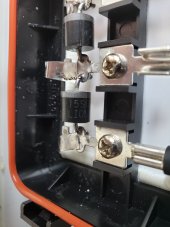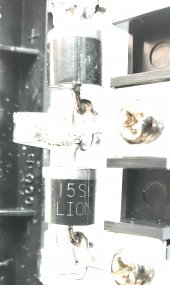What is a good source for bypass diodes? And what is the best way to spec them for a specific panel?
For example, if a panel is ~21 volts, 3 in series, each 11 amps, rated at 200 watts?
I've searched several electronics suppliers and I don't notice anything that seems appropriate.
Can anyone tell me the value of these diodes from the photo below? Can they be tested in circuit (without removing)?

For example, if a panel is ~21 volts, 3 in series, each 11 amps, rated at 200 watts?
I've searched several electronics suppliers and I don't notice anything that seems appropriate.
Can anyone tell me the value of these diodes from the photo below? Can they be tested in circuit (without removing)?

Attachments
Last edited:



